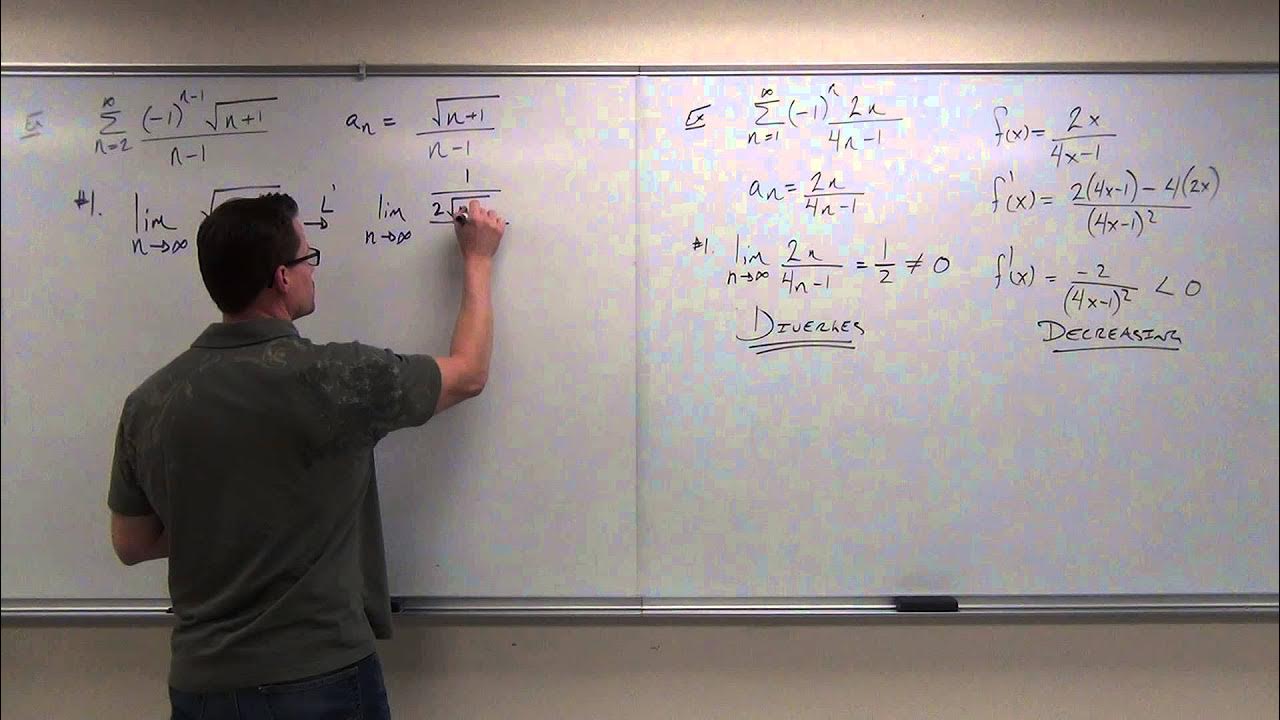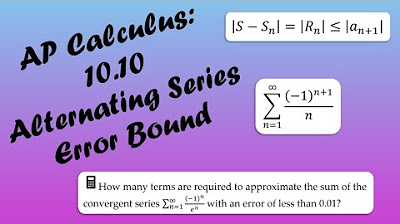Alternating series remainder | Series | AP Calculus BC | Khan Academy
TLDRThis educational video script delves into the concept of infinite series, specifically an alternating series that converges according to the alternating series test. It demonstrates how to estimate the sum of the series without calculating the entire sequence, by calculating the partial sum of the first four terms and analyzing the remainder. The script provides a hands-on approach to understanding the bounds of the series' sum, showcasing a method to approximate the series' value and its error margin, highlighting the importance of the first omitted term in the estimation process.
Takeaways
- 🌐 The video explores an infinite series starting from n = 1 to infinity, involving terms of the form (-1)^(n+1)/n^2.
- 🔍 The series is alternating, with positive and negative terms, and it is shown to converge based on the alternating series test.
- 🧩 The series is estimated by calculating a partial sum of the first four terms, denoted as S_4, and considering the remainder.
- 📊 The partial sum S_4 is calculated as 115/144 without the need for a calculator.
- 🔎 The remainder is shown to be positive and less than the first term not included in the partial sum, which is 1/25.
- 📚 The video demonstrates that the remainder R_4 is greater than zero and less than 1/25, establishing bounds for the actual sum.
- 📉 The sum of the series is bounded between 115/144 and 115/144 + 1/25, providing a range for the series' convergence value.
- 💡 The video emphasizes that for an alternating series that satisfies the alternating series test, the magnitude of the error in estimation is no more than the magnitude of the first term not included in the partial sum.
- 📌 The video provides a concrete example to illustrate the concept and encourages viewers to pause and think about the logic behind the calculations.
- 📘 The approach shown can be generalized for other alternating series, highlighting the importance of understanding the series' behavior and the potential for error estimation.
Q & A
What is the infinite series discussed in the script?
-The infinite series discussed is the alternating series starting from n equals one to infinity of (-1)^(n+1) / n^2.
What is the purpose of the alternating series test mentioned in the script?
-The alternating series test is used to determine whether an alternating series converges. It is mentioned to show that the series in the script satisfies the test's conditions and thus converges.
How does the script estimate the value S of the infinite series?
-The script estimates the value S by calculating the partial sum of the first four terms and then considering the remainder, which is the sum of the series from the fifth term to infinity.
What is the partial sum S_sub_four calculated in the script?
-The partial sum S_sub_four is calculated as 115/144, which is the sum of the first four terms of the series.
Why is the remainder of the series R_sub_four considered to be positive?
-The remainder R_sub_four is considered positive because when pairing terms from the series, each pair results in a positive value, as a smaller negative term is subtracted from a larger positive term.
How does the script prove that the remainder R_sub_four is less than 1/25?
-The script proves this by pairing terms and showing that the remainder is a sum of positive terms, each less than the next, starting from 1/25 and subtracting smaller positive terms, thus ensuring the sum is less than 1/25.
What is the significance of the number 115/144 in the script?
-115/144 is the calculated partial sum of the first four terms of the series, which serves as a lower bound for the estimation of the series' sum S.
What is the upper bound for the sum S given in the script?
-The upper bound for the sum S is calculated by adding 0.04 (which is 1/25) to 115/144, resulting in a value less than 0.83861 repeating.
How does the script use the concept of remainder to estimate the error in the series sum?
-The script uses the remainder to estimate the error by showing that the actual sum of the series is the partial sum plus the remainder, and by proving bounds on the remainder, it provides an estimate of how close the partial sum is to the actual sum.
What is the practical application of estimating the error in an infinite series as shown in the script?
-Estimating the error in an infinite series is useful in various mathematical and scientific applications where an approximation of the sum is needed. It helps in understanding the range within which the actual sum lies, without having to compute the entire series.
Outlines
📚 Introduction to Infinite Series Estimation
This paragraph introduces the concept of estimating the sum of an infinite series. It begins by defining the series as an alternating series with terms of the form (-1)^(n+1)/n^2, starting from n=1 to infinity. The speaker calculates the first few terms and notes the pattern of the series. They explain that the series converges based on the alternating series test and aim to estimate the sum, S, by calculating a partial sum of the first four terms, S_sub_four, and identifying the remainder. The speaker provides a manual calculation for the partial sum and discusses the remainder's significance in estimating the actual sum.
🔍 Analyzing the Remainder and Estimating the Series Sum
In this paragraph, the focus is on bounding the remainder of the series to estimate the sum more accurately. The speaker demonstrates that the remainder, R_sub_four, is positive by pairing terms and showing that the series of paired terms results in a positive sum. They further prove that the remainder is less than 1/25, providing a clear upper bound for the series' error. The speaker uses this logic to establish that the actual sum of the series is greater than the partial sum of the first four terms but less than the sum of this partial sum and the upper bound of the remainder. They conclude by using a calculator to refine the bounds, giving a range within which the series sum, S, lies.
Mindmap
Keywords
💡Infinite Series
💡Alternating Series Test
💡Convergence
💡Partial Sum
💡Remainder
💡Common Denominator
💡Estimation
💡Error Bounds
💡Positive Term
💡Bounding
💡Calculator
Highlights
Exploration of an infinite series starting with n equals one, involving negative one to the power of n plus one over n squared.
The series is alternating with terms like positive one, negative one over four, positive one over nine, and so on.
The series converges according to the alternating series test.
Estimation of the series' convergence value without calculating the entire series.
Calculation of the partial sum of the first four terms to estimate the series' value.
The remainder of the series is the difference between the actual sum and the partial sum of the first four terms.
The actual sum is the sum of the partial sum and the remainder.
A manual calculation of the partial sum resulting in 115/144.
The remainder is proven to be positive by pairing terms.
The remainder is less than the first term not included in the partial sum, which is 1/25.
The logic used to prove the remainder's bounds is based on the proof of the alternating series test.
The sum of the series is bounded between the partial sum and the upper bound of the remainder.
Using a calculator to refine the approximation of the series' sum.
The calculated bounds for the series' sum are 0.79861 repeating and 0.83861 repeating.
The takeaway is the ability to estimate the error of an alternating series based on the first term not included.
Transcripts
Browse More Related Video

Calculus 2 Lecture 9.5: Showing Convergence With the Alternating Series Test, Finding Error of Sums

AP Calculus BC Lesson 10.10

Alternating Series Day 2

Alternating Series Test and Error for Alternating Series

Worked example: alternating series remainder | Series | AP Calculus BC | Khan Academy

Calculus BC – 10.10 Alternating Series Error Bound
5.0 / 5 (0 votes)
Thanks for rating: